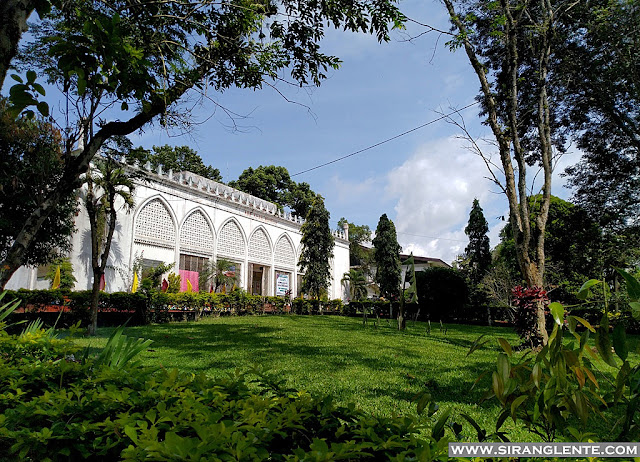
About Lanao del Sur
Lanao del Sur, the heart of the Maranao homeland, is a province rich in culture, history, and natural beauty. Nestled around the serene Lake Lanao, it is home to majestic mosques, intricate okir art, and the world-famous Darangen epic. From the royal heritage of Marawi to the breathtaking landscapes that surround it, Lanao del Sur offers a glimpse into a vibrant Mindanaoan identity rooted in pride and tradition.
About Marawi City
On the other hand, Marawi City, the capital of Lanao del Sur, is one of the cities in the Bangsamoro Autonomous Region of Muslim Mindanao. It has a colorful culture and is overflowing with stunning attractions and destinations. Before my solo backpacking, whenever I shared my itinerary, the common response of my friends was, "It is not safe in there." That negative statement did not affect my travel plan.
Tourist Spots in Marawi City
Aga Khan Museum
The Aga Khan Museum in Marawi City showcases the rich cultural heritage of the Maranao people and other Muslim communities in Mindanao. It features traditional art, crafts, weaponry, and artifacts that reflect the region’s deep history and Islamic influence, making it a must-visit destination for anyone seeking to understand Mindanao’s vibrant culture.
The Ground Zero
The Ground Zero in Marawi City stands as a solemn reminder of the 2017 siege that devastated the city. Once a bustling center of life, it now symbolizes resilience and recovery as the people of Marawi rebuild their homes, culture, and identity from the ruins of war.
Marawi's Rizal Park
Marawi’s Rizal Park is a peaceful and historic landmark that honors the legacy of Dr. José Rizal while showcasing the Maranao people’s pride and resilience. Surrounded by greenery and cultural symbols, it serves as a gathering place for locals and visitors to reflect on the city’s history, unity, and enduring spirit.
The Golden Mosque
The Golden Mosque in Marawi City stands as a magnificent symbol of faith and resilience in the heart of Lanao del Sur. Its golden dome gleams under the sun, reflecting the rich Islamic heritage and deep spirituality of the Maranao people. Beyond its striking architecture, the mosque serves as a sanctuary for worship, peace, and community unity.
Lake Lanao
Lake Lanao is the largest lake in Mindanao and the second largest in the Philippines. Surrounded by lush mountains and serene landscapes, it serves as a vital water source and a symbol of life and culture for the Maranao people.
How to Get to Marawi City
By Air: Book a flight from Manila to Laguindingan Airport. Philippine Airlines, Cebu Pacific, and AirAsia have their regular flights to CGY. At the airport, ride in a Van to the Iligan City Integrated Terminal or Iligan Jeepney Southbound Terminal. Ride in an FX to Marawi City (MSU).
This is Day 2 – 7 Days Solo-Backpacking in Mindanao
Northern Mindanao, Davao Region, BARMM
Solo-Backpacking in Marawi, Lanao del Sur
From Iligan City proper, I rode a habal to the Southbound Terminal, where I rode in a van to the city; travel time was about 45 minutes to an hour. At first, I felt awkward because I was sitting between two Muslim ladies. But felt more awkward-eerr when I spoke in Tagalog while paying the fare to the driver. Everyone was staring at me! That moment was a blessing in disguise because my seatmates started chatting with me in Tagalog. "San ka pupunta?" "May kakilala kaba?" "May dadalawin kaba?" Those questions were thrown at me. I just smiled and responded "Wala, mag-lilibot-libot lang ako sa mga tourist spots dito." They were friendly and welcoming!

I alighted at the intersection inside the Mindanao State University because I noticed an amazing landscape with a relaxing ambiance (photo above). The breeze was cool and fresh, very conducive for learning. From there, I walked on the street to the Aga Khan Museum, where I learned a lot about the culture of the Maranaos.

The Aga Khan Museum of Islamic Arts is one of the must-visit tourist destinations in Marawi City, Lanao del Sur, and it is inside the MSU campus. It was Dr. Mamitua D. Saber who founded the museum on June 13, 1962, and it was inaugurated on March 23, 1969. From the University Folks Arts Center, it was renamed to the Aga Khan Museum to honor Aga Khan IV, who donated the current museum building. By the way, the Aga Khan Museum holds the largest Filipino Muslim collection in the Philippines.


Aga Khan Museum's objective is to collect and preserve folk art specimens and artifacts of Muslim groups and other indigenous minorities. To organize a systematic collection that could be useful to scholars and researchers of the Philippine Muslim Culture. To encourage research in and lend assistance to the revival and salvaging of folk arts. To spread knowledge about the people of these regions in an effort towards cultural integration.
After completing the museum exhibit, I walked to their City Terminal using Google Maps. While waiting for the departure, I tasted some of their local delicacies and returned to Iligan City. I rode in a habal-habal to the Tambo Terminal, where I rode in a bus bound for Cagayan de Oro City.
Summary
Lanao del Sur is a living tapestry of faith, artistry, and resilience—where every lake ripple, torogan carving, and warm smile tells a story of heritage and hope. A journey here isn’t just about discovering a place, but understanding the spirit of a people who continue to shine with dignity and culture.
Looking for travel ideas across the country? Read my complete guide to visiting all 82 provinces in the Philippines — based on my actual travels.

No comments:
Post a Comment
Enter Comment Below: